Exotic elegance, noble appearance of palm trees attract many gardeners and flower lovers, however they are quite expensive and demanding in care, so indoor plants that visually look like a palm tree are becoming increasingly popular. They are an excellent decoration of various interiors and fill the interior space with a special tropical charm.
Being representatives of different families, these flowers require different conditions of detention. To choose the most suitable instance for a particular room, you need to clearly present its features and needs.
Content
Indoor plants of other species, most similar to palm trees
Real representatives of the Palm family require special conditions for growth and development. They need a lot of light, but direct exposure to the sun is contraindicated. Vital is humid air, the availability of sufficient free space.
In the realities of the apartment, it is rather difficult to create conditions corresponding to such requirements. A great solution is to purchase palm-like plants. Such instances look very impressive, but require much less maintenance.
Bokarneya
The birthplace of this unpretentious representative of the plant world is Mexico. It is resistant to temperature extremes, does not require frequent watering and can withstand even a slight drought. Bokarney does not bloom inside the apartment, but he feels quite comfortable even next to heating radiators. This home flower can be left unattended for a long time.
Bokarneya (Bottle tree) has a thick barrel in the form of a bottle, which expands below. Above is a lush bunch of ribbon-like leaves.
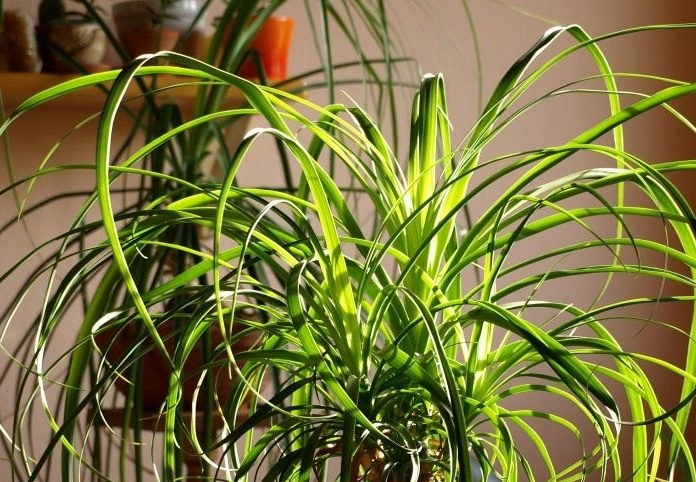
When caring for a flower, you need to adhere to such recommendations:
- place it near the southwestern or southern windows;
- maintain indoor temperature from 10 to 26 degrees;
- when spraying, do not allow moisture to enter the trunk;
- watering should be carried out every week in the summer as the soil dries, and in winter, reduce the intensity of irrigation. When the heat sets in, it is recommended to place the pot in a container of water;
- from April to October, it is recommended to feed the flower every two weeks.
Dieffenbachia
This tropical evergreen is of Hispanic origin. It is characterized by rapid growth and in five years reaches two meters in height, delighting with beautiful variegated oval-shaped leaves. At home, Dieffenbachia does not bloom. Its distinctive feature can be considered a thick green stem, on which large oval leaves are evenly arranged.

When caring for this exotic flower, you should follow some rules:
- protect it from drafts and sharp temperature drops;
- provide good lighting, protecting the flower from direct sunlight;
- use for watering plentifully only defended boiled water;
- in winter, reduce the intensity of soil moisture;
- trim only with protective gloves, as Dieffenbachia emits toxic substances.
Dracaena
This African tropical plant is a lush shrub of straight sharp leaves. Its height reaches 40 cm. You can create a crown and adjust the splendor of a room flower yourself, cutting the top of the trunk. In this case, two branches are formed at the place of the cut.It is recommended that the cut top be placed in water, and when roots appear, transplanted into the ground.
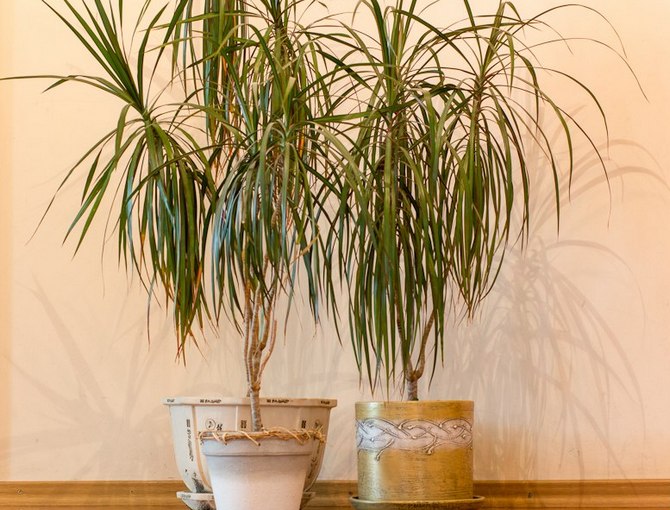
Dracaena does not require increased attention in care. Its favorable development can be ensured by adhering to several conditions:
- create diffuse intense lighting;
- provide abundant soil moisture, loosening it every time before watering;
- water the plant every two days in the summer, every three days in the winter;
- transplant the flower in a large capacity on time.
Yucca
Yucca is an evergreen plant of the Agave family from South America. There are many of its varieties that grow well in open spaces in temperate climates. Some of them calmly endure even noticeable frosts. Yucca blooms with white inflorescences from elegant large-sized bells.
This palm-shaped flower has a woody stem, which when grown inside the apartment can reach two meters in height. Large long leaves in the shape of a sword evenly extend from the stem up and to the sides. In the greenhouse, varieties with upright thick stems are grown, which end in a lush bunch of green leaves.
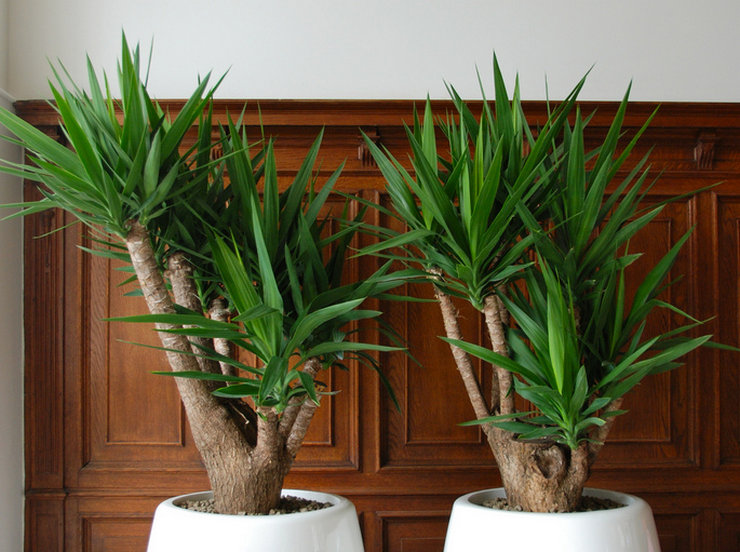
Yucca is easy to care for. To do this, create certain conditions:
- place the flower near the western or eastern windows, and in winter it is desirable to highlight;
- due to its resistance to direct sunlight in summer, it can be moved to open air;
- in the cold season, Yucca feels good at a temperature of 7-12 degrees, and when kept inside an enclosed space, it is necessary to ventilate the room from time to time;
- in the summer, Yucca needs to be watered abundantly, preventing the soil from drying out to a depth of more than 3 cm, and in winter, watering should be moderate;
- the leaves of the plant are recommended to be sprayed with settled boiled water or washed in the shower, preventing water from entering the ground;
- from April to October, it is recommended to feed the flower once a week with liquid fertilizer.
Indoor plants from the Palm family
Several types of palm trees are suitable for home cultivation. It is worth familiarizing yourself with the most common and unpretentious plants in order to make the right choice.
Areca
It has many varieties. In nature, Areca can grow up to 20 meters. In an apartment, plants that grow from the soil in the form of a bush are bred. Cirrus foliage bright green covers the upper part of thin stems.
The most popular indoor representative is Chrysalidocarpus, which is found in the wild in Madagascar, in tropical Asia and Oceania. Several stems of the same thickness rise from the pot, forming a dense bush with dense foliage. At home, it almost never blooms.
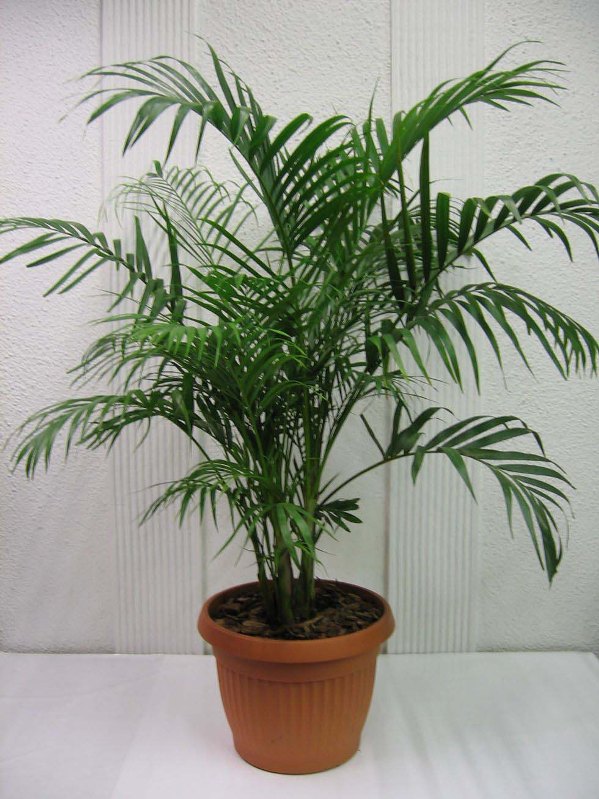
Caring for a home Areca is quite simple. To do this, adhere to the following rules:
- provide bright lighting, periodically ventilate the room in the heat, and in winter use additional light sources;
- in the warm season, maintain a temperature of + 22-25 degrees Celsius, and in winter, prevent it from lowering below + 16 ° C;
- Areca requires high humidity, so it must be constantly sprayed, and in winter wipe the leaves with a damp cloth;
- For irrigation, warm, settled water should be used. In summer, Areca is watered abundantly, so that the soil dries out no more than 2-3 cm. In winter, watering should be reduced;
- It is important to feed the soil from April to October twice a month, and in the winter to apply fertilizer monthly.
Liviston
This palm tree belongs to the fan variety, which is characterized by a dissection of leaves into three quarters of the length. At home, it grows to two meters.The leaves of such specimens are found on cuttings up to 60 cm long, which grow from the base of the stem. An adult plant has a spectacular appearance.
When caring for this domestic plant, it is recommended to adhere to the following rules:
- maintain indoor temperature from 14 to 22 degrees Celsius throughout the year;
- water only with soft, settled warm water as the soil dries;
- periodically you need to spray the leaves and remove dust from their surface with a damp cloth, for young specimens - to arrange a warm shower;
- fertilize the soil in the spring and summer three times a month, and in the autumn and winter - monthly.
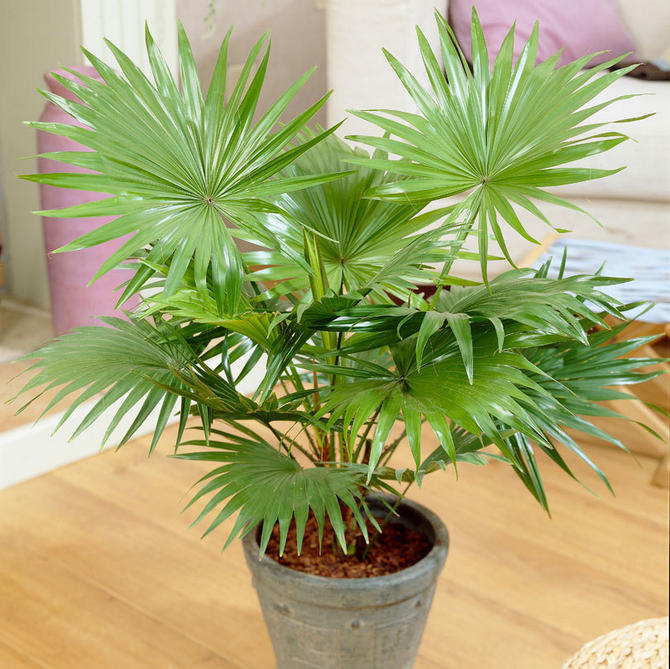
Trachicarpus
It is considered the most resistant to low temperatures among representatives of the palm family. Adult specimens with a formed trunk can withstand frosts down to -15 degrees Celsius. A fan-shaped deciduous crown is located on the upper part of the fibrous trunk. Green leaves have a bluish tint at the edges. Often found in Crimea.

To care for Trachicarpus at home should be according to certain rules that take into account its features:
- maintain the optimal temperature for this palm tree - 18-25 degrees;
- the room in which the plant is located must be periodically ventilated;
- protect leaves from direct sunlight, providing bright diffused lighting;
- use light soil with good drainage, do not flood the plant, as this often causes rotting of the root system;
- once a month a warm shower should be arranged for the leaves; to moisten the air, you can put a container of water next to the plant;
- in the spring-summer period, fertilizer must be applied monthly.
Hamedorea
It features an original form that attracts many lovers of home plants. Hamedorea is characterized by unpretentiousness, resistance to various conditions. Young specimens have a pale green color, which darkens with age. The main feature of this species is flowering at the very beginning of its life. To form the most magnificent bush, often 2-3 processes are planted simultaneously.

Growing this type of palm tree in an apartment is quite simple, following proven recommendations:
- maintain the temperature throughout the year within 13-27 degrees of heat;
- periodically ventilate the room;
- Provide good diffused light, protection from direct sunlight;
- periodically turn the pot around its axis;
- water a palm tree liberally 2-3 times a week, avoiding stagnation of water;
- wash the leaves with a damp sponge;
- every two weeks to feed the flower with liquid fertilizer.
Rapis
This decorative look refers to bamboo palm trees that have the shape of a bush. From the ground, this palm tree sprouts with numerous bamboo-like stems that end with dark green fan leaves. Rapis will fit perfectly into the interiors of small apartments.
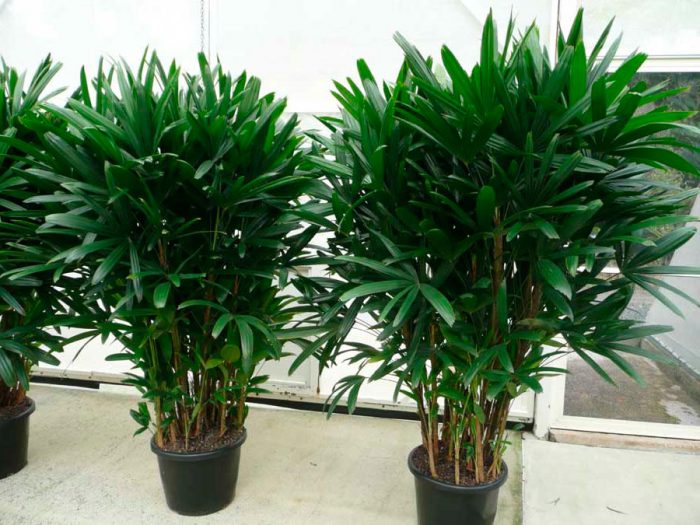
Any person can look after him, following specific instructions. When leaving, you need to carry out the following actions:
- provide bright diffused light, periodically rotate the plant;
- It is not recommended to sharply change the light;
- maintain room temperature by regularly ventilating the room;
- more favorable conditions for wintering will be a decrease in temperature to 10-16 degrees;
- in the summer it is important to provide abundant, and in winter - moderate watering with warm, settled water;
- The plant should be fed only in the spring-summer period, using complex fertilizer on a mineral basis.
Common questions
Palm trees attract many gardeners with an abundance of greenery and high decorative qualities. However, if there are doubts about the success of their independent cultivation at home, you can opt for other plants that are similar to palm trees. As a rule, they are more unpretentious, while not inferior to palm trees according to external data.

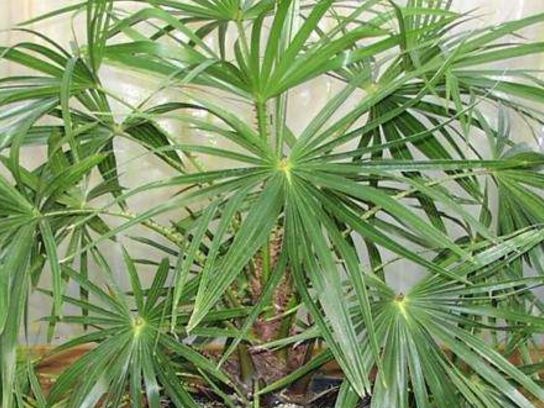
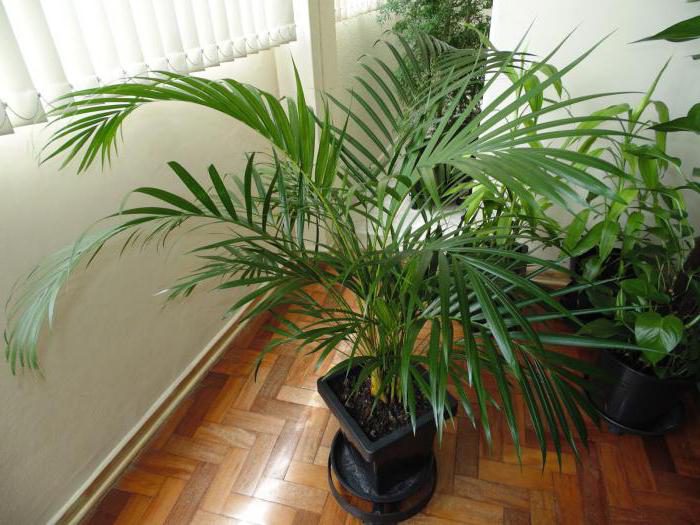




 Sow in the ground, without seedlings: 10 beautiful and unpretentious flowers
Sow in the ground, without seedlings: 10 beautiful and unpretentious flowers Platicodon planting and outdoor care
Platicodon planting and outdoor care Hosta - planting and care in the open ground in the Urals
Hosta - planting and care in the open ground in the Urals Oleander - care and growing at home
Oleander - care and growing at home